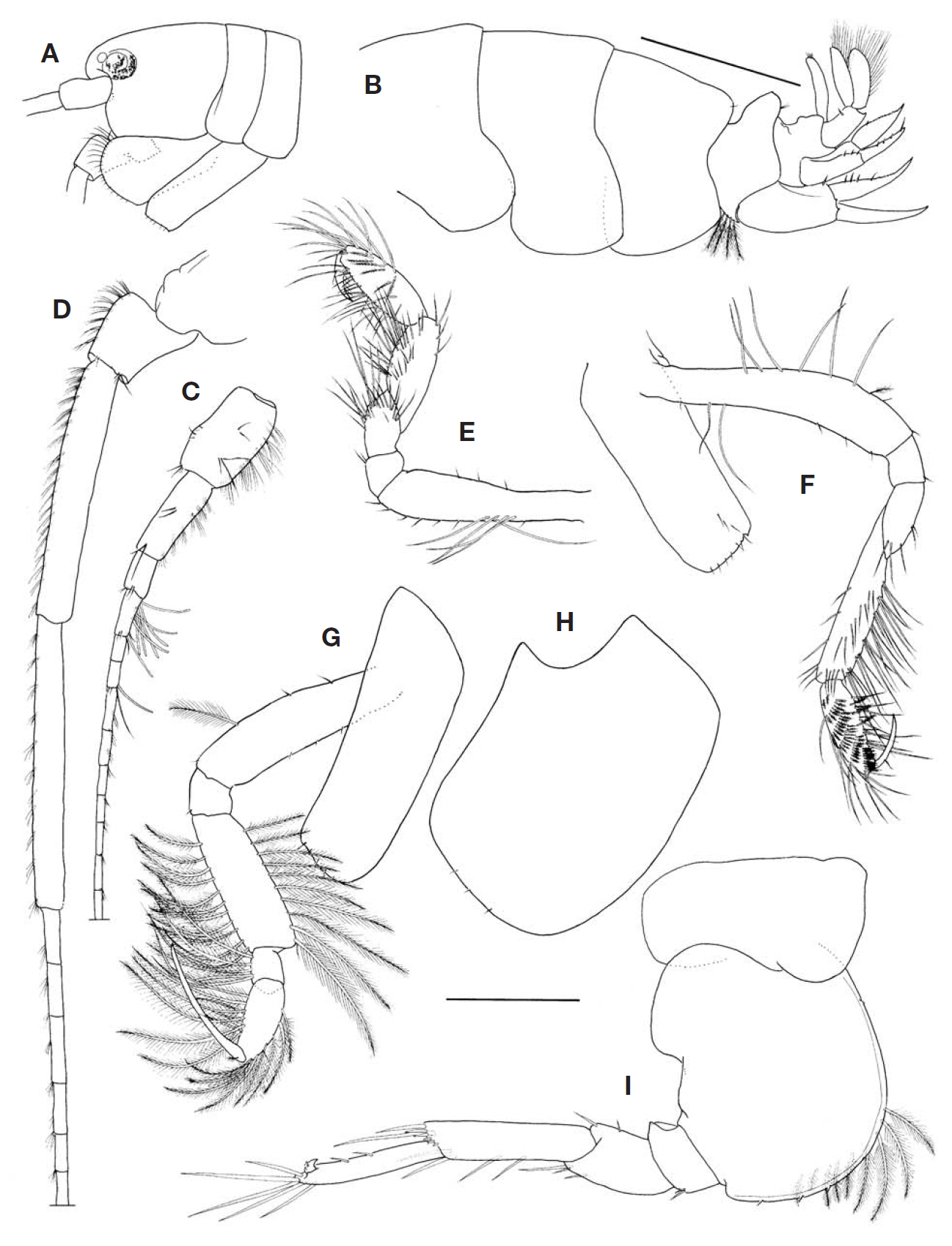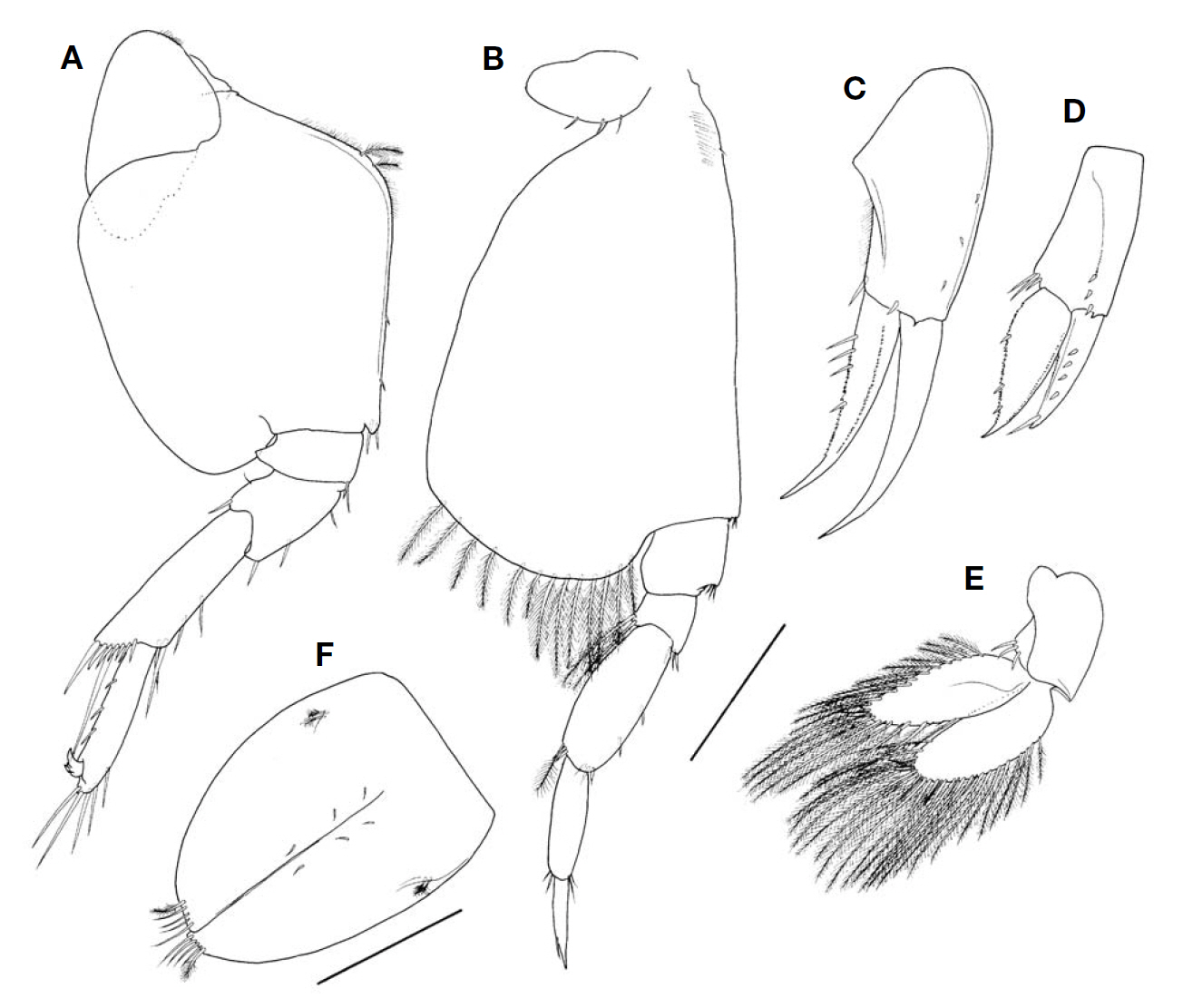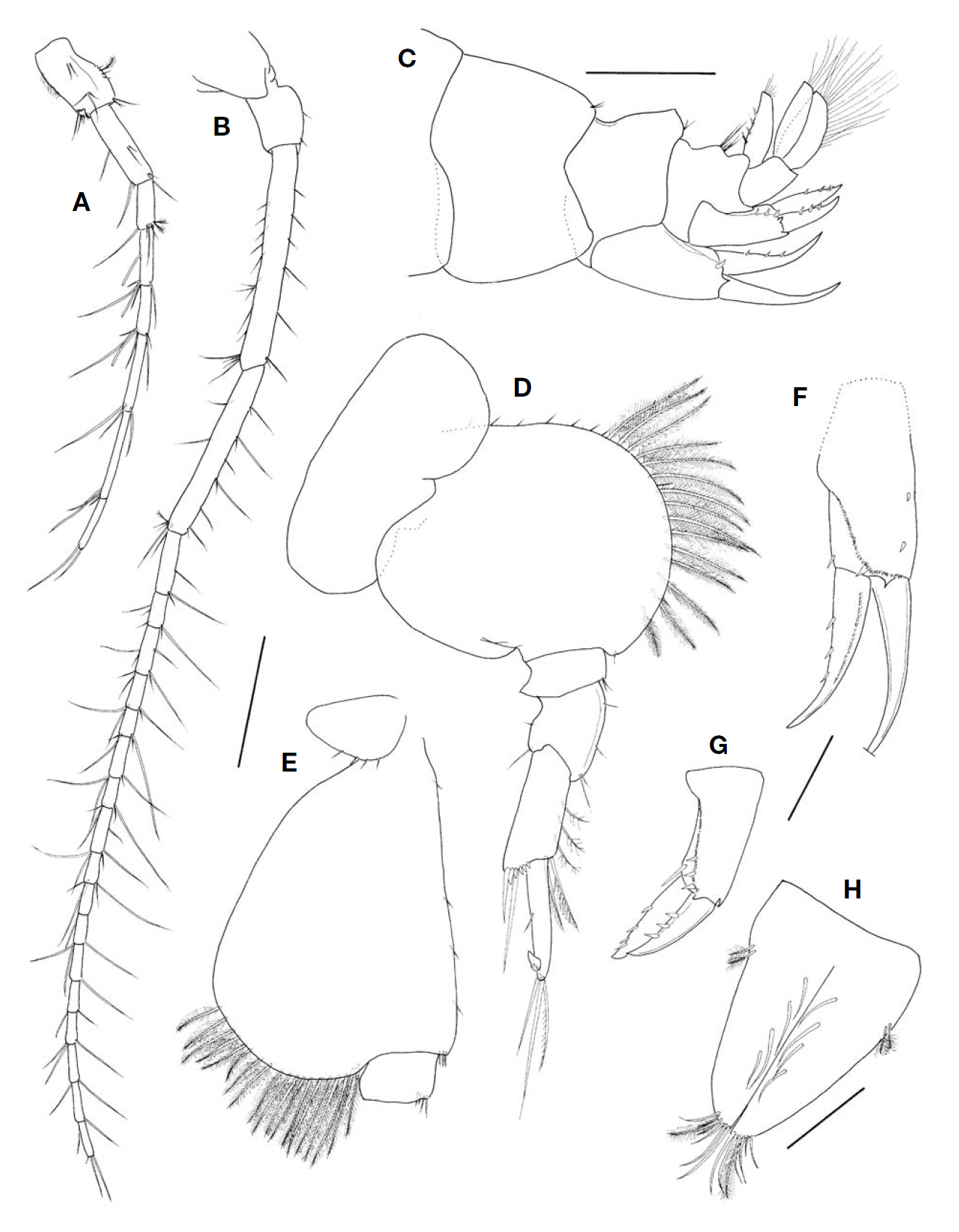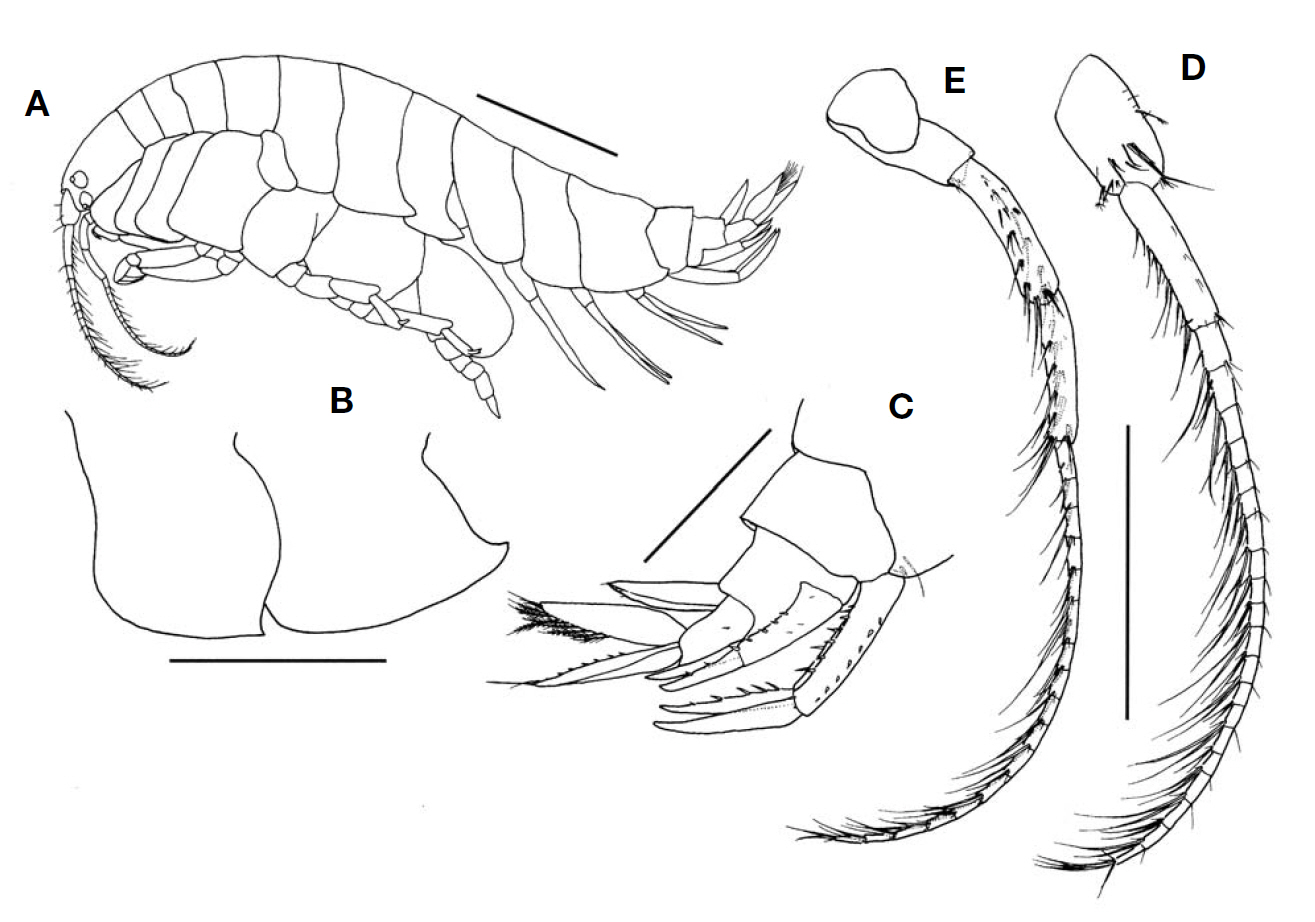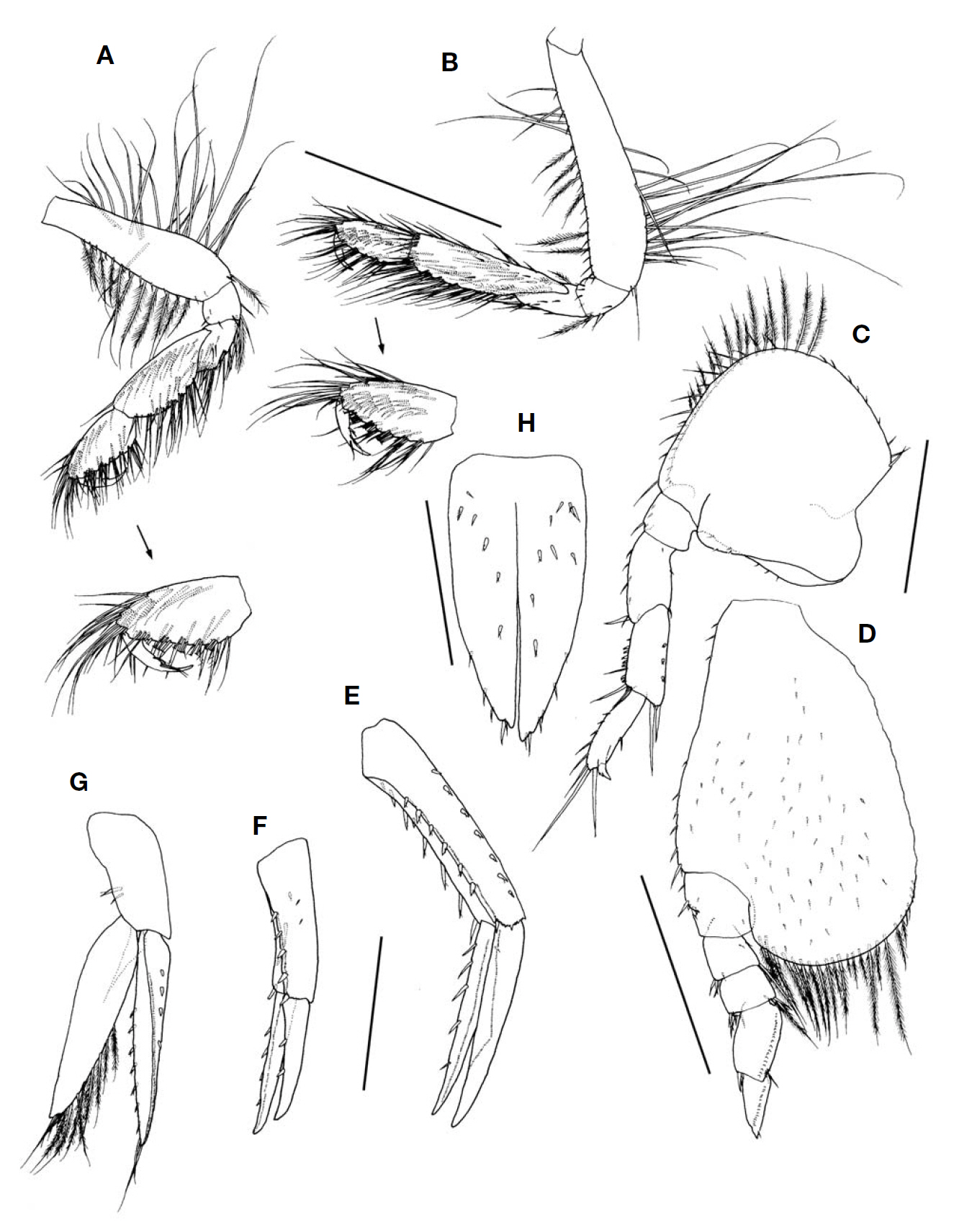



Due to their large size and high abundance, ampeliscid amphipods are a major food item of benthic marine vertebrates and invertebrates, and therefore constitute an important component of many littoral and sublittoral marine fauna (Coyle and Highsmith, 1989). In the Bering Sea, ampeliscid accumulations are dense and cover a large portion of the sea floor, where they are routinely fed upon by grey whales (Oliver et al., 1984).
The purpose of the present study is to report on two additional species,
Order Amphipoda Latreille, 1816
Suborder Gammaridea Latreille, 1803
Family Ampeliscidae Costa, 1857
Genus Ampelisca Krøyer, 1842
1*
31♂♂, 1♀, Korea: Jeollanam-do, Wando-gun, Isl. Nohwado, 23 May 1998, Lee CM.
Body 6.9 mm long, smooth and laterally compressed. Head (Fig.1 A) about 1.4 times as long as pereonites 1-2 combined. Rostrum rather short, bluntly protruded apically, reaching 1/2 or less to the middle of peduncular article 1 of antenna 1. One pair of corneal lens well developed, small, rounded, visible laterally. Pereonite 5 to pleonite 2 with weak dorsodistal elevation. Epimeral plates 1-3 (Fig.1 B) subquadrate, without distinct posteroventral tooth; epimeral plate 3 concave posteriorly. Urosomite 1 with strong keel dorsodistally; urosomites 2-3 coalesced, with weak protrusion dorsomedially.
Antenna 1 (Fig.1 C). Slightly less than half length of body;
peduncular article 1 slightly swollen on distal half of anterior margin, with several clusters of setal tufts posteriorly; peduncular article 2 shorter or subequal in length to article 1, with posterior setal tufts as in article 1; flagellum less setose, 22-articulate, first article bearing long aesthetascs posteriorly.
Antenna 2 (Fig.1 D). Elongate, slightly longer than the length of the body and much more than twice as long as antenna 1; peduncular articles 1-2 short, ambiguous; peduncular articles 3-5 bearing clusters of short setal tufts anteriorly; peduncular article 4 slightly shorter than article 5; flagellum 42-articulate, about 2.7 times as long as peduncle.
Gnathopod 1 (Fig.1 E). Basis subrectangular, subequal in length to carpus and propodus combined, with 5 long setae midposteriorly; carpus setose ventromedially, about 1.1 times as long as propodus; propodus ovate-elongate, all margins setose, palm short and indistinct; dactylus falcate, about half length of propodus.
Gnathopod 2 (Fig.1F). Similar to gnathopod 1, while more slender and elongate; coxa rectangular, with posteroventral notch; carpus rectangular, elongate, slightly less than twice the length of propodus; propodus ovate-elongate, with six oblique rows of pectinate setae on medial surface.
Pereopod 3 (Fig.1 G). Slender and linear; coxa rectangular, similar to coxa 2; merus about 0.7 times as long as basis, with rows of plumose setae on both margins; dactylus slender, elongate, longer than carpus and propodus combined.
Pereopod 4 like that of pereopod 3, but coxa (Fig.1 H) larger than coxa 3 and excavate posterodorsally; basis and ischium bearing plumose setae posteriorly.
Pereopod 5 (Fig.1 I). Coxa wider than long, weakly bilo-
bate; basis ovate, anterior margin convex throughout, with 9 plumose setae midanteriorly, proximal half of posterior margin with backward protruding lobe; ischium short, subacutely produced posterodistally; carpus rectangular, with unequal spines distally, slightly longer than propodus; dactylus short, with 3 small teeth dorsally.
Pereopod 6 (Fig.2 A). Similar to pereopod 5 except for basis anterior margin relatively straight, without posterior protruding lobe.
Pereopod 7 (Fig.2 B). Coxa smallest of all pereopods, with 3 short setae ventrally; basis large, 0.6 times as wide as long, posteroventral lobe expanded downward, widest distally, distal expansion not reaching distal end of ischium, bearing row of plumose setae; merus short, 0.7 times as long as ischium, with 2 plumose setae posterodistally; dactylus lanceolate, about 0.8 times as long as propodus, with feeble seta laterally.
Uropod 1 (Fig.2 C). Peduncle stout, as long as outer ramus, with 2 distal and 3 basofacial spines and small distal tooth; inner ramus slightly shorter than outer, inner and medial margins serrate, with 4 setiform spines on inner margin; outer ramus smooth, usually lacking spine, but sometimes bearing 1 small spine dorsoproximally.
Uropod 2 (Fig.2 D). Peduncle longer than rami, with 3 dorsolateral and triad apicomedial spines; both rami dissimilar; inner ramus broadly foliaceous, tapering toward apex, inner and medial margins serrate; outer ramus with 4 lateral and 1 subdistal spines, inner margin serrulate.
Uropod 3 (Fig.2 E). Peduncle stubby, with 3 distal spines; rami foliaceous, subequal in length, bearing long plumose setae marginally.
Telson (Fig.2 F). Ovate, widest in middle, narrowing distally, 0.7 times as wide as long, deeply cleft (75%), apex slightly truncate, with two pairs of penicillate setae in the sublateral margins, three pairs of feeble setae in the middle portion, four pairs of simple and one pair of penicillate setae distally.
Body length about 5.5 mm, similar to male in shape, but obviously distinguished from male by several parts; antenna 1-2 (Fig.3 A, B) short, with rather long setae, lacking setal tufts on the peduncles. Urosomite 1 (Fig.3 C) with lower dorsal keel than that of male. Pereopod 5 (Fig.3 D) basis elliptical, both margins convex, with row of plumose setae anteriorly; carpus shorter and wider than that of male. Pereopod 7 (Fig.3 E) basis more setose ventrally, slightly wider than that of male, about 0.7 times as wide as long. Uropod 1 (Fig.3F) peduncle dorsolateral margin serrate; inner margin of inner ramus lacking serration. Uropod 2 (Fig.3 G) inner and outer rami similar to each other, inner margins of rami lacking serration. Telson (Fig.3 H) dorsal surface with four pairs of relatively long setae in tandem.
China (South China Sea) and Korea (southwestern coast).
1*Ampelisca miharaensis Nagata, 1959 (Figs. 4, 5)
Korea: Jeollanam-do: 6♂♂, Wandogun, Wando port, 20 May 1998, Lee CM; 4♂♂, Wandogun, Isl. Nohwado, 23 May 1998, Lee CM; Chungcheongnam-do: 1♀, Taean-gun, Isl. Sinjindo, 3 Apr 1999, Kim YH;1♂, Taean-gun, Isl. Gauido, 8 Jul 2000, Kim YH; Jeollanamdo: 4♀♀, Jinteo, Isl. Oenarodo, 30 Jul 2001, Kim YH; 1♂, Seomang, Isl. Jindo, 28 Jun 2004, Kim YH; 1♂ 2♀♀, Maryang, Gangjin-gun, 2 Jul 2004, Kim YH; Incheon-si: 1♂, Gobongpo, Isl. Baekryeongdo, 13 Jul 2007, Hong SS.
Body (Fig.4 A) 5.1 mm long. Head subrectangular, anterior and posterior sides nearly uniform in width, gradually narrowing apically, about 1.6 times as long as pereonites 1 and 2 combined. Two pairs of corneal lens well developed, visible laterally, located close to antennal corner and lateral cephalic lobe, respectively. Epimeral plate 2 (Fig.4 B) convex posteriorly, with pointed posteroventral corner; epimeral plate 3 produced posteroventrally,with subacute posteroventral tooth. Urosomite 1 (Fig.4 C) weakly elevated dorsodistally, urosomites 2-3 coalesced.
Antenna 1 (Fig.4 D). Setose, more than twice as long as
head, ratio of length of peduncular articles 1-3=1.00 : 1.08 : 0.30; peduncular article 1 stubby, about 2.2 times as wide as article 2; flagellum 20-articulate, 1.6 times as long as peduncle, provided with long setae on articles.
Antenna 2 (Fig.4 E). Setose, subequal in length to antenna 1; peduncular articles 1-2 short; peduncular article 4 as long as article 5; flagellum 17-articulate, slightly longer than peduncle, posteriorly provided with a pair of long setae on each article.
Gnathopod 1 (Fig.5 A). Basis subrectangular, slightly widening distally, subequal in length to carpus and propodus combined, anterior margin with a row of plumose setae and spinules, posteriorly with about 20 unequal long setae, posterodistal corner with plumose setae; carpus 0.40 times as wide as long, about 1.4 times as long as propodus, slightly convex posteriorly, with several clusters of posterior and medial setae; propodus palm gently slanted, longer than ventral margin, with several groups of unequal setae; dactylus falcate, 0.6 times as long as propodus.
Gnathopod 2 (Fig.5 B). Similar to gnathopod 1, but more slender and elongate; basis slightly longer than carpus and propodus combined, anterior margin with plumose and simple setae and row of spinules, posterior margin with short to long setae; carpus about 0.3 times as wide as long, about twice length of propodus; propodus simple, palm gently slanted, 2.3 times as long as ventral margin; both margins and medial portions of carpus and propodus covered with many setae; dactylus falcate, not reaching palmar corner.
Pereopod 6 (Fig.5 C). Basis subquadrate, anterior margin convex, strongly expanded, with a row of simple setae, central half with plumose setae, posterodistal lobe roundly produced; merus and carpus subequal in length and width; propodus shorter and slender than carpus.
Pereopod 7 (Fig.5 D). Basis large, longer than articles 3-7 combined, anterior margin slightly concave medially, with small spines, posteroventral lobe expanded downward, convexly curved, reaching distal end of merus, armed with row of plumose setae; ischium longer than merus, slightly shorter than merus and carpus combined; merus longer than carpus;dactylus lanceolate, tapering distally, 0.8 times as long as propodus.
Uropod 1 (Fig.5 E). Slightly extending beyond end of
uropod 2; peduncle rectangular, with 7 dorsolateral, dorsomedial and basofacial spines, respectively, outer distal margin serrulate, slightly longer than rami; inner ramus as long as outer, with a row of 5 dorsal spines; outer ramus without spines.
Uropod 2 (Fig.5 F). 0.6 times as long as uropod 1; peduncle 1.2 times as long as inner ramus; outer ramus 0.9 times as long as inner one, with 2 dorsal spines; inner ramus with 4 spines.
Uropod 3 (Fig.5 G). Peduncle much shorter than rami, with 2 dorsal spines; rami elongate and lanceolate, inner ramus subequal in length to outer one, distal half of inner margin with row of plumose setae, outer ramus with two rows of spines and 2 apical setae.
Telson (Fig.5 H). Elongate, extending beyond end of peduncle of uropod 3, narrowing distally, 0.5 times as wide as long, deeply cleft (83%), each lobe with dorsal and apical setae or setiform spines.
China Sea, Japan, and Korea (west and southwest coasts).
Our specimens from Korea are congruent with Nagata’s (1959) original description, while minor morphological differences are found: 1) antenna 2 more than half of the body length in the original description, while one fourth in our specimens; 2) antenna 1 peduncular article 2 about 1.5 times as long as article 1 in the original description, while slightly longer than article 1 in our specimens; 3) antenna 2 peduncular article 5 longer than 4 in the original description, while subequal in length to each other in our specimens; 4) in the original description, the posteroventral lobe of the pereopod 7 basis reaching the distal end of the ischium, while extending far beyond the end of the ischium in our specimens.
>
Key to species of the genus Ampelisca from Korea
1. Eyes 1 pair ????????????????????????????????????????????????????????????????2
- Eyes 2 pairs???????????????????????????????????????????????????????????????4
2. Antenna 1, peduncular article 2 subequal in length to article 1; epimeral plate 3 without a distinct posteroventral tooth ?????????????????????????????????????????????????????????????????????????3
- Antenna 1, peduncular article 2 about twice as long as article 1; epimeral plate 3 with a distinct posteroventral tooth????????????????????????????????????????????????????????????????????
3. Antenna 1, peduncular article 1 anterodistally expanded?????????????????????????????????????????????????????
-Antenna 1, peduncular article 1 uniform in width ?????????????????????????????????????????????????????????????????????????
4. Gnathopod 1, propodus with a distinctly concave palm???????????????????????????????????????????????????????????????????????
- Gnathopod 1, propodus simple, without a distinct palm 5
5. Pereopod 7, merus bearing a posterodistal lobe produced downward ??????????????????????????????????????????????
- Pereopod 7, merus lacking an elongated posterodistal lobe ??????????????????????????????????????????????????????????????????????????6
6. Gnathopod 2, carpus more than twice as long as propodus; epimeral plate 3 with a posteroventral tooth ??????????????????????????????????????????????????????????????????????????
- Gnathopod 2, carpus more than twice as long as propodus;epimeral plate 3 without a posteroventral tooth ???????????????????????????????????????????????????????????????????????

